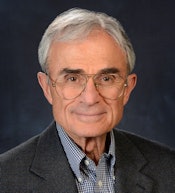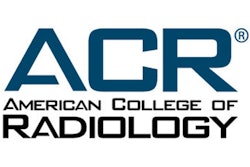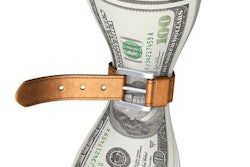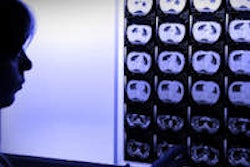
Medicare payment policies intended to curb spending for noninvasive diagnostic imaging services have been quite successful over the past decade, reducing costs to the program for these procedures by 33% between 2006 and 2015, according to a study published online April 24 in the Journal of the American College of Radiology.
Radiologists have been buffered to some extent from the impact of these cuts because they typically bill under the Medicare Physician Fee Schedule (MPFS) for the professional component of imaging procedures. This is in contrast to cardiologists, for example, who tend to be dependent on global claims, wrote a team led by Dr. David C. Levin of Thomas Jefferson University.
 Dr. David C. Levin from Thomas Jefferson University.
Dr. David C. Levin from Thomas Jefferson University."Radiologists have been hurt less than cardiologists by these reimbursement cuts because most of their work is done in hospitals, where they bill for the professional component only," Levin told AuntMinnie.com. "Professional component claims have been less affected by the Deficit Reduction Act and other cuts."
Still, these findings aren't exactly positive, Levin said.
"I wouldn't call this news about Medicare reimbursement cuts to imaging good for radiologists," he said. "Better to call it 'less bad.' "
Cost cutting
For more than a decade, U.S. policymakers have been implementing imaging reimbursement cuts through a variety of vehicles, from the Deficit Reduction Act (DRA), which took effect in 2007, to code bundling, particularly for radionuclide myocardial perfusion imaging.
To assess recent trends in Medicare reimbursement for imaging, Levin's group used Part B data from 2002 to 2015 to track noninvasive diagnostic imaging payments to radiologists, cardiologists, and all other specialists. The researchers considered total reimbursement, as well as global, technical, and professional component claims (JACR, April 24, 2017).
Total reimbursement to physicians for noninvasive diagnostic imaging peaked at $11.936 billion in 2006, Levin and colleagues found. After that, reimbursement dropped by 33% to $8.005 billion in 2015. In addition, reimbursement to radiologists peaked at $5.3 billion in 2006 and decreased by 19.5% to $4.269 billion in 2015. Cardiologists saw a 45% drop in reimbursement for noninvasive diagnostic imaging procedures, from $2.998 billion in 2006 to $1.653 billion in 2015.
The decline in reimbursement for cardiologists was due in part to their dependence on global reimbursement, which saw a 50.5% decrease from 2006 to 2015, according to the researchers.
"One result of the reimbursement reductions has been the closure of a number of cardiology private offices or their merging into hospital systems, which has tended to accelerate the drop in their global payments received," Levin and colleagues wrote. "We would have expected an increase in professional component payments to cardiologists in recent years as they ... transitioned to hospital employment but ... that increase was very minor."
Radiologists also saw a drop in global reimbursement of 40.4%, but they were somewhat protected by receiving a much larger proportion of their reimbursement for the professional component, which was not nearly as affected by Medicare payment reductions, according to the researchers.
"About 80% of radiologists' work is conducted in hospital settings," they wrote. "When radiologists bill for studies done in hospitals, they bill for the professional component only ... [and] Medicare noninvasive diagnostic imaging dollars received by radiologists through professional component billing have remained relatively stationary over the past decade."
As for all other physicians, payments for noninvasive diagnostic imaging peaked at $2.407 billion in 2006 and then dropped by 35% to $1.565 billion in 2015.
| Medicare imaging reimbursement by specialty | ||||
| Specialty | Peak payment | Year of peak payment | 2015 payment | Percent change from peak |
| Primary care | $1.029.5 billion | 2006 | $418.1 million | -59% |
| Orthopedic surgery | $353.6 million | 2011 | $301.3 million | -15% |
| Vascular surgery | $154.5 million | 2015 | $154.5 million | None |
| Internal medicine | $238 million | 2006 | $147.5 million | -38% |
| Other surgery | $154.1 million | 2006 | $113 million | -27% |
| Urology | $145.3 million | 2009 | $80.8 million | -44% |
| Ob/gyn | $73.4 million | 2011 | $59.9 million | -18% |
| Nonphysician providers | $51.4 million | 2015 | $51.4 million | None |
| Chiropractic/podiatry | $57.2 million | 2010 | $51.1 million | -11% |
| Neurology | $85.8 million | 2006 | $48.2 million | -44% |
In any case, radiologists are still the primary providers of imaging: In 2015, radiologists received 53.3% of noninvasive diagnostic imaging payments to physicians under the MPFS, while cardiologists received 20.7%, Levin and colleagues noted. All other physicians as a group received 19.6%, and independent diagnostic testing facilities (IDTFs) and multispecialty groups received 6.5%.
Effective effort?
The effort to curb imaging spending has been pretty effective, according to the researchers. In fact, reimbursement amounts to physicians for noninvasive diagnostic imaging were at about the same level in 2015 as they had been in 2002.
"Medicare policies in recent years have had a major impact on reimbursements for noninvasive diagnostic imaging," they wrote. "On the whole, those reimbursements to physicians under the MPFS were down by one-third in 2015 compared with the peak year of 2006."
However, because part of the cost savings comes from the closure of private offices, the cost of imaging for Medicare may increase in the long run, in addition to patient access being affected, the researchers noted.
"The closure of private offices is certainly going to continue if physician owners can't cover their costs -- and that will definitely lead to reduced access for patients," Levin said. "And it could lead to two other problems as well: Medicare reimbursements to hospitals are higher than private offices, so if more imaging gets diverted to hospitals, that could raise costs for Medicare. And it could really hurt patients who have high-deductible health plans."
It's time for policymakers and payers to stop cutting imaging reimbursement, according to Levin.
"Medicare has already achieved huge savings. Payments to physicians for imaging in 2015 were down $4 billion compared to what they were in 2006," he said. "It's not that the cuts should stop so that radiologists' incomes are protected -- our incomes are right up there near the top among medical specialties -- but because further cuts will affect patient access to imaging, and actually could cost Medicare more in the long run."



















